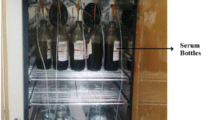Abstract
In this study, a lab-scale thermophilic anaerobic digestion of food waste collected from G-district in Seoul was performed to assess its feasibility and applicability in field-scale biogas plants. Monitoring parameters included biogas production, methane composition, pH, alkalinity, and volatile fatty acid (VFA) concentrations. Accumulation of VFA caused successive depression in pH, which inhibited microbial activity of methane-forming microorganisms. Signals of biological instability and inhibition of methanogenesis suggest possible process failure, as indicated by reduction in methane production. Results revealed that modifications in certain conditions, such as decreased organic loading rate (OLR) or additional insertion of alkalinity, must be made for its application in industrial-scale biogas plants, and that thermophilic anaerobic digestion of food waste may not be feasible without any modification.






Similar content being viewed by others
References
Korean Ministry of Environment (2013) Municipal solid wastes composition. http://stat.me.go.kr. Accessed 23 June 2015
Ghosh S, Henry MP, Sajjad A, Mensinger MC, Arora JL (2000) Pilot-scale gasification of municipal solid wastes by high-rate and two-phase anaerobic digestion (TPAD). Water Sci Technol 41:101–110
Ghosh S, Pohland FG (1974) Kinetics of substrate assimilation and product formation in anaerobic digestion. J Water Pollut Control Fed 46:748–759
McCarty PL, Smith DP (1986) Anaerobic wastewater treatment. Environ Sci Technol 20:1200–1206
Chen Y, Cheng JJ, Creamer KS (2008) Inhibition of an anaerobic digestion process: a review. Bioresour Technol 99:4044–4064
Buhr HO, Andrews JF (1976) The thermophilic anaerobic digestion process. Water Res 11:129–143
Lo KV, Liao PH, March AC (1985) Thermophilic anaerobic digestion of screened dairy manure. Biomass 6:301–315
Dupla M, Conte T, Bouview JC, Bernet N, Steyer JP (2004) Dynamic evaluation of a fixed bed anaerobic-digestion process in response to organic overloads and toxicant shock loads. Water Sci Technol 49:61–68
Jenkins SR, Morgan JM, Sawyer CL (1983) Measuring anaerobic sludge digestion and growth by a simple alkalimetric titration. J Water Pollut Control Fed 55:448–453
Ripley LE, Boyle WC, Converse JC (1986) Improved Alkalimetric Monitoring for Anaerobic Digestion of High-Strength Wastes. J Water Pollut Control Fed 58:406–411
American Public Health Association, American Water Works Association, Water Environmental Federation (2012) Standard methods for the examination of water and wastewater. Washington DC, USA
Kroeker EJ, Schulte DD, Sparling AB, Lapp HM (1979) Anaerobic treatment process stability. Journal Water Pollution Control Federation 51:718–727
Sandberg M, Ahring BK (1992) Anaerobic treatment of fish-meal process wastewater in a UASB reactor at high pH. Appl Microbiol Biotechnol 36:800–804
Ye J, Li D, Sun Y, Wang G, Yuan Z, Zhen F, Wang Y (2013) Improved biogas production from rice straw by co-digestion with kitchen waste and pig manure. Waste Manag 33:2653–2658
Ahring BK (1995) Methanogenesis in thermophilic biogas reactors. Antonie Van Leeuwenhoek 67:91–102
Franke-Whittle IH, Walter A, Ebner C, Insam H (2014) Investigation into the effect of high concentrations of volatile fatty acids in anaerobic digestion on methanogenic communities. Waste Manag 34:2080–2089
Rodrigues LS, Silva IJ, Oliveira PR, Pinto ACA, Lima CA (2014) Influence of the ratio IA/PA and volatile acids in the monitoring of UASB reactor in the treating of swine waste water. J Water Resour Prot 6:526–531
Pereira EL, Campos CMM, Monterani F (2009) Effects of pH, acidity and alkalinity on the microbiota activity of an anaerobic sludge blanket reactor (UASB) treating pig manure effluents. Revista Ambiente e Agua 4:157–168
Voβ E, Weichgrebe D, Resenwinkel KH (2009) FOS/TAC-Deduction, Methods, Application and Significance. Internationale Wissenschaftskonferenz “Biogas Science 2009—science meets practice” LfL-Bayern 2-4 12.09, Erding
Akuzawa M, Hori T, Haruta S, Ueno Y, Ishii M, Igarashi Y (2011) Distinctive responses of metabolically active microbiota to acidification in a thermophilic anaerobic digestion. Microbial Ecol 61:595–605
Cho HS, Moon HS, Lim JY, Kim JY (2013) Effect of long chain fatty acids removal as a pretreatment on the anaerobic digestion of food waste. J Mater Cycles Waste Manag 15:82–89
Hill DT, Cobb SA, Bolte JP (1987) Using volatile fatty acid relationships to predict anaerobic digester failure. Trans ASAE 30:496–501
Yamashiro T, Lateef SA, Ying C, Beneragama N, Lukic M, Masahiro I, Ihara I, Nishida T, Umetsu K (2013) Anaerobic co-digestion of dairy cow manure and high concentrated food processing waste. J Mater Cycles Waste Manage 15:539–547
Angelidaki I, Ellegaard L, Ahring BK (1993) A mathematical model for dynamic simulation of anaerobic digestion of complex substrates: focusing on ammonia inhibition. Biotechnol Bioeng 42:159–166
Acknowledgments
This study was supported by the Korea Ministry of Environment as “Climate Change Correspondence R&D Program” and “Waste to Energy-recycling Human Resource Development Project.” We also appreciate the technical assistance of Institute of Construction and Environmental Engineering at Seoul National University.
Author information
Authors and Affiliations
Corresponding author
Rights and permissions
About this article
Cite this article
Kim, J.R., Kim, J.Y. Feasibility assessment of thermophilic anaerobic digestion process of food waste. J Mater Cycles Waste Manag 18, 413–418 (2016). https://doi.org/10.1007/s10163-015-0458-8
Received:
Accepted:
Published:
Issue Date:
DOI: https://doi.org/10.1007/s10163-015-0458-8




